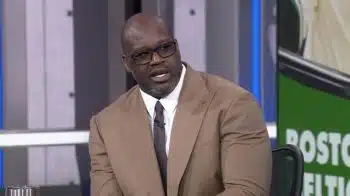NBA
Why Are There 82 Games in an NBA Season?

The Players’ Tribune does this thing where they ask players “fair or foul” questions meant to be quick hits on how they feel about certain issues, and Dallas Mavericks guard Devin Harris recently intimated that he’d be in favor of shortening the regular season, though the nature of the feature didn’t really give him much of an opportunity to explain his reasoning.
LeBron James, in a 2014 interview with ESPN.com, did expound a little, however.
“It’s not the minutes, it’s the games,” James said. “The minutes don’t mean anything. We can play 50-minute games if we had to. It’s just the games. We all as players think it’s too many games. In our season, 82 games is a lot. But it’s not the minutes. Taking away minutes from the game is not going to shorten the game at all.”
James and Harris are by no means the only players to call for a shorter NBA season. Kobe Bryant, for example, told Sports Illustrated over the summer that he believes a shorter season would decrease injuries while also increasing the value of the remaining regular season games.
“You can’t [just] lose five-to-10 games,” Bryant told SI. “If you’re going to do it, you’ve almost got to go quality versus quantity. If you’re going to shorten the schedule, then you’ve got to shorten the schedule and look to enhance your TV numbers substantially… because now every regular-season game is worth a s—.”
Strong words from a player who stopped mincing them years ago, but it’s an important point for an issue that may never go away. Owners make an average of around $173 million in revenue per year, which equates to an average of $2.1 million per game over an 82-game season. Cutting the season down to, say, 70 games could cost owners over $25 million on average, and bigger market teams like New York, L.A., and Chicago inevitably would lose even more than that.
That certainly explains why owners would be reticent to drop the total number of games played, especially when each individual exhibition is more profitable now than it ever has been, but how did the NBA decide on an 82-game season in the first place?
***
When professional basketball first started to gain some momentum over the course of the first third of the 20th century, teams played a similar slate of games as what we see now for college basketball teams. However, just like today’s students have classes to attend, early professionals had day jobs to pay their bills, which meant basketball was a secondary activity rather than the all-encompassing athletic odyssey it is today.
Then, the National Basketball Association formed, with all 11 teams playing 60 games over the course of the season, though that number was shortened the following year with only seven teams playing 48 games each. As new franchises popped up, however, and as the game grew increasingly profitable, the NBA slowly added a few games here and there until they got to 80 in 1961-1962, then 81 in 1966-1967, and finally 82 the year after that.
Since then, there have been only two instances of the league playing fewer than 82 games, and both of those instances occurred as a result of lockouts and concurrent temporary work stoppages.
But why 82 games? Why land on such an arbitrary number as the foundation for the length of a major professional sports league? Apparently, it had everything to do with how hard owners could push the athletes without injuring them.
According to Slate, playing right around 80 games over the course of a six-month season would offer the tightest balance between profitability and the health of employees. In other words, it was about money. It’s always about money.
It’s been almost 50 years since that decision was made, and the game is more intense than it ever has been, particularly with teenage athletes spending so much time participating in AAU and international competitions at ever-younger ages. Weight training is more intensive, as are offseason workouts. It’s a different game now, yet players still chug along at max speed for 82 games a year.
One can’t help but wonder if a new assessment of revenue versus injury risk would come out differently based on the intensity and rigor of today’s game.
***
What would it take to shorten the season, then, even slightly? As Kevin Arnovitz of ESPN.com explained in a 2014 article, it would require some sort of exploration into discovering a balance between the profitability of games and the scarcity of games, which has worked quite well for NCAA’s March Madness and, of course, the NFL.
“In Economics 101, students learn about the utility or indifference curve, and how to find the sweet spot on the graph where a product’s availability matches market demand,” explained Arnovitz. Finding that balance isn’t easy, especially for those larger television markets that have huge TV deals that center around quantity over quality.
Still, as Arnovitz suggests, reducing the number of games dramatically (he suggests 44 games) would make every game more valuable and the season in general more unpredictable. It’s the importance of every single game and the unpredictability of both NFL games and March Madness games that have earned those organizations some of the biggest broadcasting deals in pro sports. For the NBA to drop games from its schedule, they’d need to bring in even more money, which doesn’t seem likely since they only recently nailed down the largest television deal in league history.
In other words, the concept of dropping games from the schedule is fun to talk about, but the potential revenue-losing experimentation required to find the sweet spot between player rest and league profitability means change probably isn’t coming any time soon.
Whatever the reason, the league settled on 82 games almost five decades ago and it stuck. It’s going to take a lot more than a few player opinions to change it at this point.











